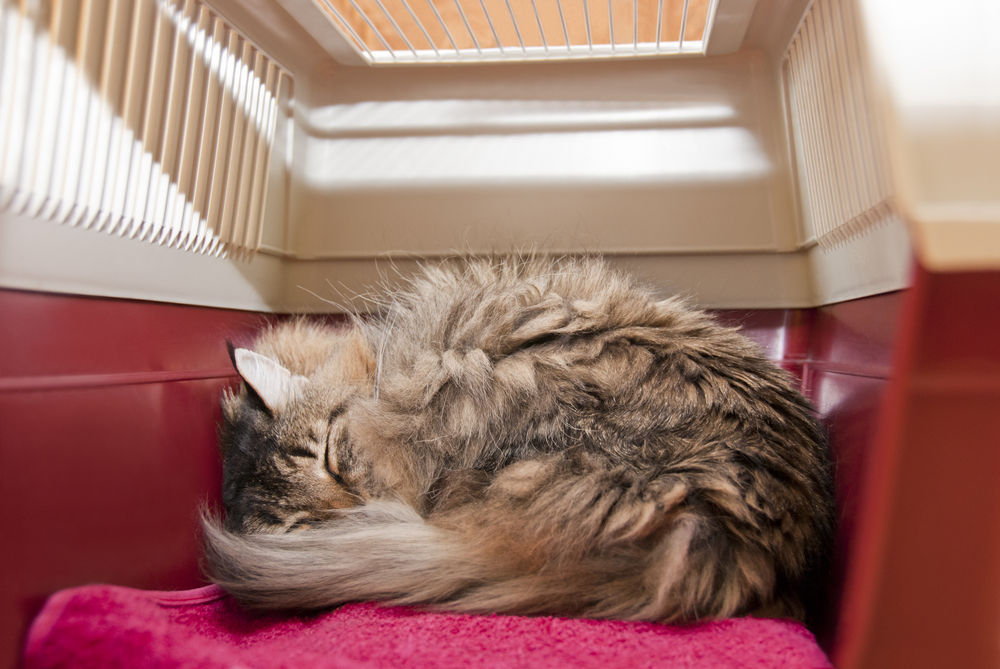

A cat’s ability to move around and perform daily activities depends on the ability of its brain, spine, nerves and muscles to coordinate in tandem. This complex communication system involves nerves in the brain sending messages about the outer environment to the body, and the body sending messages to the brain regarding what it is actually experiencing in the environment. These messages are transmitted through nerves in the spinal cord, which is embedded in the vertebral, or spinal, column. Together, the nerves in the brain and spinal cord make up the body's central nervous system. A trauma to any part of the nerve pathway can result in miscommunication or complete lack of communication to the brain or body, and an inability to coordinate the body's movements.
The spinal column itself consists of a set of 24 bones called the vertebrae, which are separated from each other by small cushions called intervertebral discs. Together the vertebrae and intervertebral discs protect the spine from damage. Trauma to the vertebrae or disks can create a vulnerability to the nerves within the spinal cord, resulting in further trauma to the neural pathway.
When a cat is experiencing paralyzation, it is often because communications between the spinal cord and the brain have been disrupted. In some cases, the cat will not be able to move its legs at all (paralysis), and in other cases, there may still be some communication between the brain and spine and the cat will only appear to be weak, or will have difficulty moving its legs, a condition called paresis – partial paralysis. There are also cases where a cat may be paralyzed in all four legs (tetraplegia), and in others, the cat may be able to control the movement in some of its legs but not all. This is determined by the location in the brain, spine, nerves, or muscles that the trauma has occurred.
You will need to give a thorough history of your cat's health, onset of symptoms, and possible incidents that might have led to this condition, such as tick bites, or injuries that occurred while jumping or falling. During the examination, your veterinarian will pay close attention to how well your cat is able to move its legs, and how well it is able to respond to reflex tests. The veterinarian will also test your cat's ability to feel pain in all four legs, checking the head, spine, and legs for signs of pain and alertness to touch.
All of these things will help your veterinarian to locate where in your cat's spine, nerves, or muscles it is having a problem. Basic laboratory tests, including a complete blood count, biochemical profile and urine analysis will be conducted, and may determine if your cat has an infection - bacterial, viral, or toxin based - that is interfering with the nerve pathway. X-ray images of your cat's spine may show evidence of an infection or malformation of the vertebrae, or a slipped disc that is pressing against the spinal cord. Other conditions that can lead to disruption of the nerve pathways may be apparent on an x-ray, such as tumors, blockages, or inflamed nerves.
In some cases, your veterinarian may order a special x-ray called a myelogram. This process uses injection of a contrasting agent (dye) into the spinal column, followed by x-ray images which will allow the doctor to see the spinal cord and vertebrae in more detail. If these imaging techniques are not helpful, your veterinarian may order a computed tomography (CT) or magnetic resonance image (MRI) of your cat's brain and spine, both of which give an extremely detailed picture of your cat's brain and spine. In some cases, your veterinarian may take a sample of the fluid from around your cat's spine for analysis, or samples from the muscles or nerve fibers for biopsy. These analyses may determine the presence of an infection in the brain or spine.
The course of treatment will depend on the cause of your cat's paralysis. If your cat is unable to walk, urinate, or defecate on its own, it will most likely be admitted into hospital while your veterinarian works to settle on a diagnosis. From there your veterinarian will monitor your cat daily to follow its recovery and progress. If your cat is in pain, it will be given medication to help manage the pain, its bladder will be emptied several times per day by catheter, and it will be physically adjusted throughout the day to make sure that it does not get sores from lying in one place for too long. If the cause of the paralysis is infection or a slipped disc, the condition will be treated with either medicine, surgery or therapy. Tumors or blockages of blood supply may be repaired surgically, depending on the vulnerability of the location. Some paralyzed cats recover very quickly. Depending on the severity of the condition, your cat may be kept in hospital until it is able to walk, or your veterinarian may send your cat home with you with a guideline for home care and recovery.
Your veterinarian will help you to make a plan for caring for your cat at home. At times your cat may resist your care because of pain, but firm and gentle care will help to diffuse the fearful reactions. If possible, ask a second person to help hold the cat while you are administering care, or swaddle the cat so that it cannot scratch or run away.
It is important that you care for your cat properly so it can recover completely. Follow all of your veterinarian’s instructions carefully. If your veterinarian has prescribed medication, be sure to administer the full course, even after your cat appears to have fully recovered. If you have any questions or problems caring for your cat, ask your veterinarian for help, and do not give pain relievers, or any other drug to your cat without first consulting your veterinarian, as some human medications can be toxic to animals. In some cases, if the paralysis cannot be treated but your cat is otherwise healthy, your cat may be outfitted with a special wheelchair (cart) to help it walk. Most cats with carts adjust well and continue to enjoy their lives. Needless to say, if your cat has been affected with a paralyzing condition, it should be neutered or spayed so that it does not risk being further injured by mating.
 Sleek Cat Tree Suits Modern Cozy Places
Felines Love (and Need) to Climb
Cred
Sleek Cat Tree Suits Modern Cozy Places
Felines Love (and Need) to Climb
Cred
 High Blood Pressure in Cats
Systemic Hypertension in Cats
Hypertension
High Blood Pressure in Cats
Systemic Hypertension in Cats
Hypertension
 How to Repel Cats From Property
How to Repel Cats From Property
How to
How to Repel Cats From Property
How to Repel Cats From Property
How to
 Acne in Cats
Acne in Cats
Cat acne is found almost exclusively on the
Acne in Cats
Acne in Cats
Cat acne is found almost exclusively on the
 Anal Sac Disorders in Cats
Cats have anal glands which produce fluid into sa
Anal Sac Disorders in Cats
Cats have anal glands which produce fluid into sa
Copyright © 2005-2016 Pet Information All Rights Reserved
Contact us: www162date@outlook.com